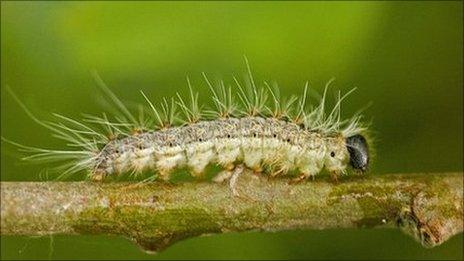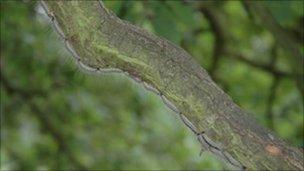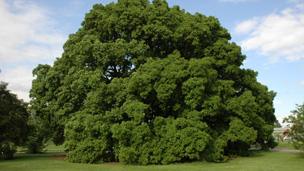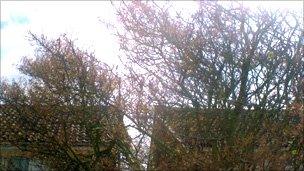Fight to halt toxic caterpillars
- Published

The oak processionary moth caterpillar was discovered in England in 2006
For the past two days, Tony Kirkham has been spraying insecticide on hundreds of oak trees at Kew Gardens to keep a toxic caterpillar at bay.
The caterpillars of the oak processionary moth (OPM) damage oak trees by feeding on their leaves, while its toxin-containing hairs pose health risks to people.
The moth has taken hold in five London boroughs despite attempts to eradicate it after its arrival in the UK five years ago.
Head of arboretum Mr Kirkham said the Royal Botanic Gardens had been "fighting to eradicate it" since three caterpillar nests were identified at the site in 2006.
He said the outbreak spread into the famous gardens from imported trees used in a housing development in nearby Kew Village.

Mr Kirkham is concerned about the many stresses affecting oak trees
The south-west London gardens originally fought the problem by removing caterpillar nests but found the insects returned every year, and in 2009 about 450 European oaks were affected.
"We've begun spraying again this year and many of our neighbours are doing the same", said Mr Kirkham.
"The more people that treat it, the more chance we have of keeping it in check."
Mr Kirkham said he had been "very sensitive" to the tiny toxic hairs on the caterpillars and quickly developed a rash after any contact.
The Health Protection Agency has warned people to avoid the caterpillars, which can cause itchy skin patches and itchy eyes. Asthma UK has also said the insect's tiny hairs can trigger asthma attacks.
Mr Kirkham, who has worked at Kew for more than 30 years, had feared the introduction of "keep out" signs in the gardens because of health concerns over the caterpillars.
'Here to stay'
The moth's persistence in the UK has raised concerns for Britain's beloved oaks.
Mr Kirkham said the caterpillar infestations rarely led to the death of the trees, but they were weakened by their defoliation as they were less able to make food through photosynthesis.
He said trees had seen weeks of drought and were under pressure from other pests and diseases and feared an OPM epidemic could "tip the balance for oak trees".

The moth is named after the way the caterpillars move in nose-to-tail processions
Mr Kirkham added: "I am confident that I can manage OPM here on the Kew site, but worry for others in the industry who aren't able to do what I am doing."
The Forestry Commission said it had been working with councils and other bodies in London to protect the "iconic tree of England" against the moth.
Roger Coppock, head of specialist advisors, said they had managed to significantly reduce the problem in treated areas, but this year the commission moved to a policy of "containment" in the five boroughs as eradication had not worked.
"It's likely the pest will be here to stay in this area," he added.
'Instant trees'
The commission's aim is stop the pest spreading and a six-mile (10km) "buffer zone" has been created around the boroughs.
Its policy is to eradicate the moth in other areas where it crops up, such as in Pangbourne, Berkshire, where it was found last month.

The Forestry Commission has brought in measures to protect oak trees
Mr Coppock said the main reason for new pests and diseases - not just moths - in the UK was due to the international trade in plants.
He said British gardeners were increasingly using the internet to import plants from abroad, while trees where being imported for landscape designs and developments.
All oak trees coming into the UK from the EU now need a "plant passport" to confirm they are OPM free.
The commission is also contributing to the EU Plant Health Review to help protect the country from pests and diseases.
Olympic Park is among places in London which will not use oak trees as part of efforts to combat the bug.
Natural predators
Meanwhile, an increase in other types of caterpillars has been seen around England, with experts saying the unusually warm spring was responsible.
Infestations of brown-tail moth caterpillars, which can also cause rashes and respiratory problems, have been seen in Sussex and Essex.
David Clarke, of Bexhill, East Sussex, said he had noticed "spider-web-like" tents containing hundreds of caterpillars over a 15ft shrub in his front garden for the first time this year.
"They munched through the big shrub and stripped away nearly every leaf," he said.
He said the leaves of the shrub were normally so dense they obscured birds on the branches.

David Clarke's shrub is normally thick with leaves in spring
Mr Clarke and his neighbour, who had the caterpillars over his rose bushes, came out in itchy rashes when then came into contact with the hairy insects.
Richard Parker-Harding, Rother District Council's head of environmental health said brown-tail moth caterpillars had been in the area for more than 30 years, but added "cases of infestation do appear to be higher this year".
Mr Coppock said the species, which ate foliage and shrubs, was native to Britain and was "not a major concern" for the commission.
"It will have natural predators which will eat the insect," he said.
- Published19 May 2011
- Published2 August 2010